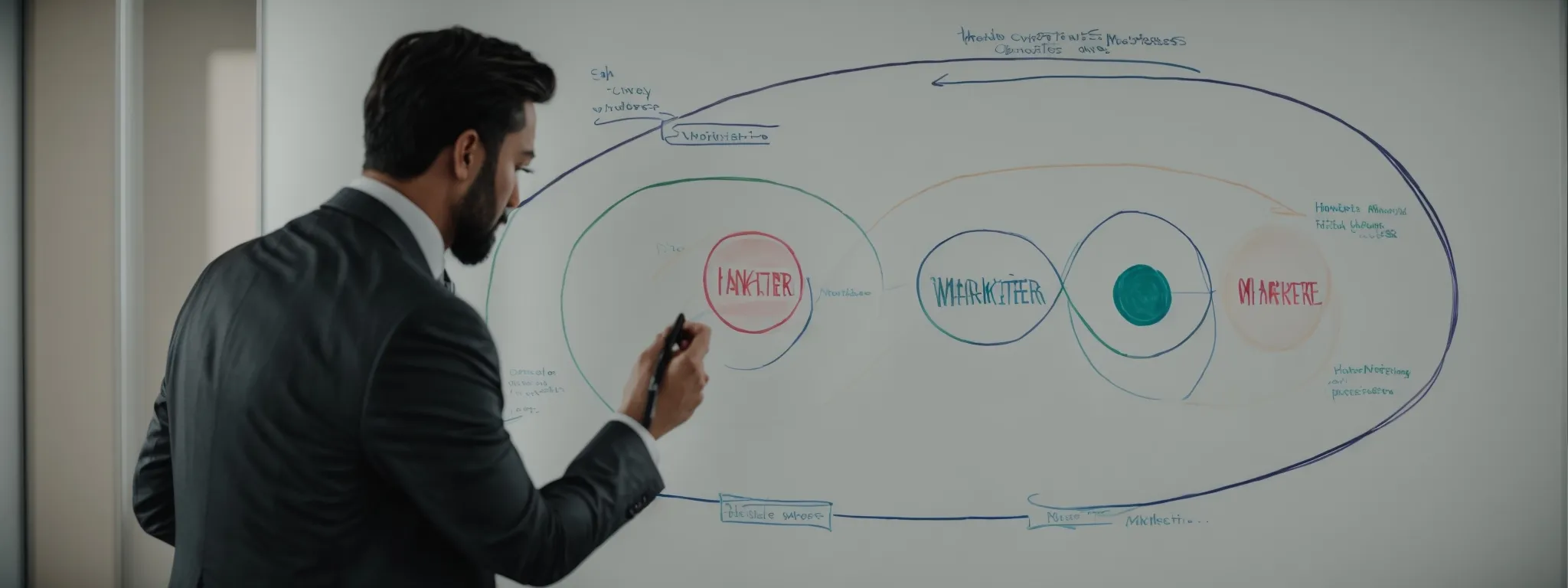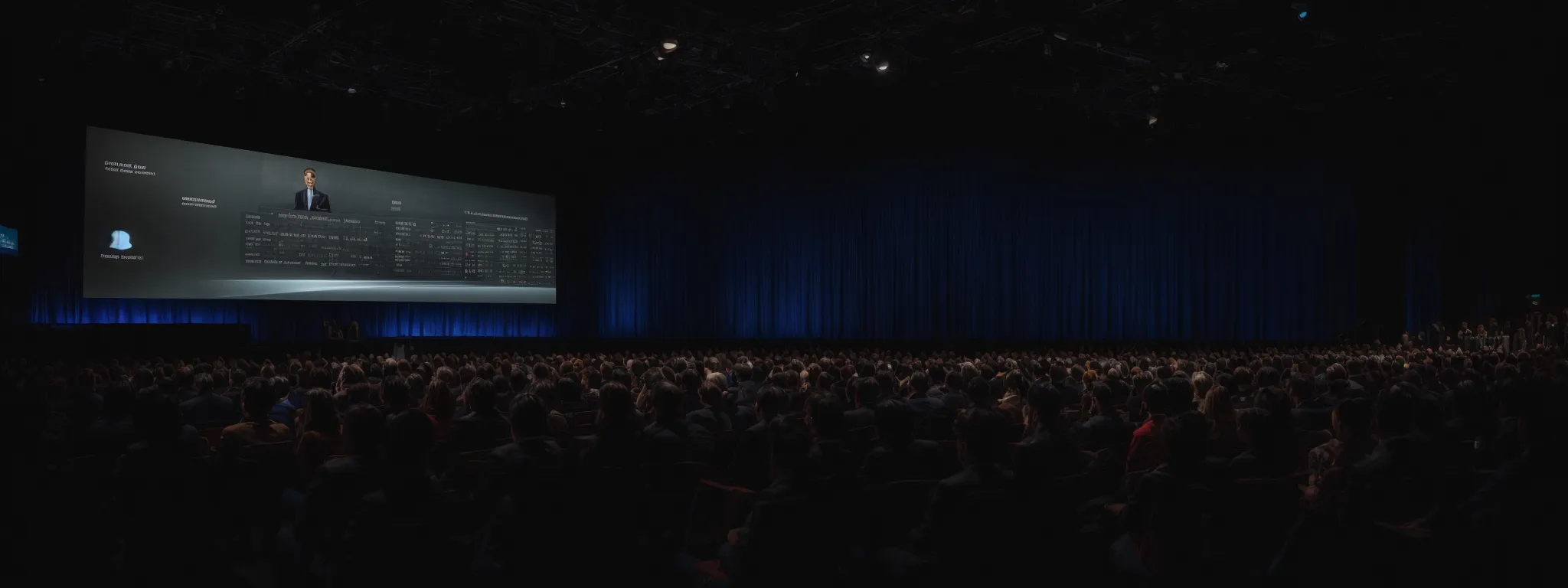Brilliant Ways to Combine Traditional Digital Marketing
Seamless Strategies for Merging Traditional and Digital Marketing Initiatives In a world where clicks and views often dominate the marketing narrative, the savvy integration of traditional marketing […]
Seamless Strategies for Merging Traditional and Digital Marketing Initiatives
In a world where clicks and views often dominate the marketing narrative, the savvy integration of traditional marketing tactics with digital strategies can produce a symphony of brand awareness and consumer engagement.
Executives and marketers recognize that leveraging the strengths of both realms can create more impactful, dynamic, and cohesive marketing campaigns.
Be it a catchy jingle on the radio or an immersive PPC campaign, the confluence of these techniques has the ability to resonate with a diverse audience on multiple sensory and communication levels.
This amalgamation paves the way for a marketing approach that is both revolutionary and familiar, enticing the customer through their entire journey.
Keep reading to explore how businesses can fine-tune their marketing orchestrations to capitalize on the harmonious blend of old and new.
Key Takeaways
- Traditional and Digital Marketing Methods Work Best When Integrated to Create Comprehensive Campaigns
- Digital Marketing Tools Can Enhance the Effectiveness of Traditional Tactics Through Data Analytics and Targeted Engagement
- The Integration of Direct Mail With Digital Insights Leads to More Personalized and Effective Consumer Outreach
- Modern Technology Like QR Codes and NFC Enhances Traditional Advertising Formats, Bridging the Gap to Digital Interaction
- Events and Social Media Can Be Combined to Extend Engagement Beyond the Physical Space and Into the Digital Realm
Understanding the Synergy of Traditional and Digital Marketing

In the fast-paced realm of advertising, marketers often grapple with the integration of traditional and modern methodologies.
While each form of marketing has its unique strengths, magnifying the synergy between the two can lead to comprehensive campaigns that resonate deeply with consumers.
Identifying the inherent powers of both traditional and digital marketing permits a robust scrutiny of consumer engagement across varied mediums.
Meticulous alignment of goals paves the way for unified strategies that not only facilitate seamless consumer experiences but also enhance overall marketing effectiveness in bridging the gap between the old and the new.
Identifying the Strengths of Both Marketing Forms
Traditional marketing tactics like television ads, print media, and direct mail, bring with them a tangible presence that can be influential in reinforcing brand recognition. With the ability to reach a broad audience through an established communication channel, these techniques are instrumental in building a solid foundation of brand awareness and reaching consumers who may not be as digitally connected.
In the world of digital marketing, the focus shifts towards a more targeted approach, employing tools such as PPC Google Ads, SEO reputation management, and social media campaigns that can attract and engage a brand’s target audience. Digital strategies provide the measurable advantage of data analytics, enabling precise tracking of website traffic, user engagement, and conversion rates, which are vital for discerning and responding to consumer behavior in real time.
Examining Consumer Behavior Across Platforms
As businesses navigate the intricacies of consumer behavior, it’s crucial to recognize that the customer journey can be complex, often weaving between online and offline interactions. The savvy use of both digital and traditional channels helps to create a seamless consumer experience, underscoring the importance of integrated marketing strategies.
Understanding the cross-platform behavior of consumers allows companies to tailor their marketing efforts effectively. Insights gained from data analytics reinforce the need for a cohesive approach, ensuring that each touchpoint, be it a digital ad or a magazine insert, works in harmony to guide the consumer towards a desired action.
| Marketing Channel | Strengths | Tactics |
|---|---|---|
| Traditional Marketing | Wide reach, Tangibility, Familiarity | TV Ads, Print Ads, Billboards |
| Digital Marketing | Targeting, Analytics, Engagement | SEO, PPC, Email Campaigns |
Aligning Traditional and Digital Marketing Goals
The quest for convergence between traditional and digital marketing goals necessitates astute planning and analysis, solidified through the employment of robust digital marketing tools such as SearchAtlas SEO software. Embracing These Tools enhances digital strategies, enabling companies to orchestrate campaigns that leverage the best of both marketing worlds.
Integrating Digital PR Services and SEO Content Assistant from LinkGraph, for instance, businesses can amplify their message through both old and new media channels effectively. This dual approach ensures that every marketing activity is aligned with the overarching company objective of elevating brand exposure and engagement across every consumer touchpoint.
Crafting an Omnichannel Approach for Cohesive Marketing

In an era where customer interactions span from the tactile pages of a magazine to the dynamic interfaces of digital devices, establishing a holistic approach to marketing is imperative.
Companies committed to staying ahead of the curve are harmonizing their marketing objectives, making strides to map customer journeys that integrate touchpoints across all channels.
By leveraging the power of data to formulate an interconnected channel strategy and ensuring uniformity in messaging, these entities are setting a precedent for consistency that upholds brand integrity and fosters customer trust.
As this subsection unfolds, it will delve into the strategic practices that underpin an omnichannel marketing framework, highlighting how businesses can maintain a steadfast connection with their audience, regardless of the platform or medium.
Mapping Customer Journeys for Integrated Touchpoints
Within the sphere of an omnichannel marketing approach, the mapping of customer journeys is an intricate process that ensures all touchpoints are integrated effectively. It requires a deep dive into the consumer’s mindset, identifying each potential interaction with the brand, whether it begins with a traditional print ad and transitions into a digital landing page or vice versa.
This strategic alignment across various marketing channels sets the stage for a more personal and persuasive dialogue with the audience. By embarking on this quest, businesses are equipped to construct a coherent narrative that fluidly connects with their consumers, irrespective of the platform, thereby fostering a consistent and engaging brand experience.
Leveraging Data for a Unified Channel Strategy
In today’s digital ecosystem, companies employ data analytics as the keystone to harmonize their channel strategy, ensuring that the digital footprint augments traditional efforts rather than operating in silos. By scrutinizing data from both online and offline campaigns, firms gain invaluable insights into customer preferences and behaviors, facilitating a marketing approach that is both integrated and agile.
Data serves as the compass for Navigating the Interconnected World of omnichannel marketing, guiding businesses in orchestrating campaigns that speak directly to the heart of the consumer’s journey. Utilizing such data-driven insights, marketing teams are able to calibrate their efforts across various platforms, crafting messaging that not only resonates with their audience but also propels them towards a cohesive brand experience.
Ensuring Consistent Messaging and Branding
In the fusion of traditional and digital marketing, maintaining consistent messaging and branding is the cornerstone of a successful omnichannel strategy. As companies transition between media forms—from television spots to social media ads—it is essential that the core message remains unaltered, ensuring that the brand narrative is clear and cohesive irrespective of the medium.
It falls to the astute marketers, those who understand the nuances of a consumer’s perception, to design and execute marketing initiatives that faithfully represent the brand across all platforms. By delivering a uniform brand message, companies solidify brand recognition, thereby securing a lasting connection with their audience that transcends individual campaigns and channels.
Bridging the Gap Between Online and Offline Campaigns

In a landscape where marketing initiatives often span both digital screens and physical spaces, the key to creating impactful campaigns lies in the harmonious blending of both realms.
Seamlessly weaving strategies that synchronize digital ads with the palpable touchpoints of print media, integrating social media’s interactive immediacy with tangible in-store promotions, and orchestrating the buzz of outdoor advertising to complement and amplify the conversation online, businesses are crafting omni-channel experiences that engage consumers at every turn.
By aligning these diverse strategies, organizations effectively bridge any divide between the online and offline worlds, fostering unity in messaging and amplifying the potency of their marketing endeavors.
Syncing Digital Ads With Print Media Timelines
In the orchestration of a unified marketing approach, synchronization between digital advertisements and print media timelines is paramount. This coordination ensures a cohesive narrative, allowing a product launch announced in a magazine to be instantly echoed across digital platforms, maximizing impact and engagement.
For businesses, the strategic timing of ad rollouts across varying channels can significantly amplify their message’s reach, creating synchronized waves of exposure that enhance digital strategies and fortify brand presence in the consumer’s mind.
Integrating Social Media With in-Store Promotions
The confluence of social media and in-store promotions heralds a new frontier in marketing strategies, creating a dialogue between the online buzz and the physical retail experience. By posting time-sensitive discounts on platforms like Instagram or Twitter, retailers can drive foot traffic to stores, marrying the immediacy of online engagement with the tactile satisfaction of shopping in person.
Through strategic social media campaigns, retailers can galvanize their target audience, encouraging customers to partake in exclusive in-store events or promotions. This strategy fosters a unique ecosystem where digital appetizers lead to real-world feasts, enhancing digital strategies and enriching the overall brand narrative.
Coordinating Outdoor Advertising With Online Buzz
In the landscape of modern marketing, coordinating outdoor advertising with the digital sphere is a matter of strategic synchronicity. Captivating billboards or bus wraps that echo a digital hashtag or campaign can catch the viewer’s eye, seamlessly connecting the tactile experience of outdoor media with the participatory nature of online conversations.
This coordination can transform a passerby into an active participant in the brand’s narrative, leveraging the reach of outdoor advertising to spark engagement in the digital arena. Here, outdoor campaigns become a gateway, funneling public interest directly to the social networks and online platforms where the conversation is amplified:
- A billboard promoting a new product directs audiences to a social media contest, inviting user-generated content under a campaign-specific hashtag.
- Digital screens in public spaces showcase live social media feeds, capturing real-time consumer reactions and interactions inspired by the outdoor ad.
- QR codes placed on outdoor visuals offer instant access to a campaign landing page, bridging the gap between physical viewing and digital exploration.
Amplifying Event Marketing With Digital Tools

In an ever-evolving marketing landscape, event marketing stands as a testament to the power of human connection, yet its potential is magnified manifold when paired with digital tools.
Marketing professionals recognize the invaluable opportunity to extend their reach beyond the confines of the event space, turning single occasions into multi-channel engagement opportunities.
Promoting live events through social media platforms, utilizing email campaigns for effective follow-up, and capturing compelling event highlights for future digital content all represent strategic facets of this contemporary marketing synergy.
Each method serves a pivotal role in not merely communicating an experience but expanding its influence and lifespan within the digital sphere.
Promoting Live Events Through Social Media Platforms
When professionals seek to amplify the reach of their live events, social media platforms offer a dynamic stage for promotion. Careful crafting of event-centric content on social networks can generate buzz and foster anticipation, engaging an audience well before the curtains rise on the actual event.
Executives ensure their social media strategy aligns with event goals, using platforms like Facebook and LinkedIn to target attendees with precision and Leveraging Instagram Stories or live-Tweeting to capture real-time excitement. This integrated marketing technique not only spotlights the event but also cultivates an expansive digital community eager to connect and participate.
Using Email Campaigns to Follow-Up After Events
Post-event engagement is a critical component of the marketing follow-up process, and email campaigns are a potent tool for sustaining momentum. By promptly sending personalized emails to attendees, companies can reinforce connections, share additional resources, and set the stage for future interactions, ensuring that the energy of the event translates into enduring relationships.
Businesses utilize strategic email communications to elicit feedback, offer exclusive content, or extend special offers to participants. This approach solidifies the event’s impact, providing a direct line to the inbox of engaged individuals and thereby reinforcing the brand’s message and fostering loyalty.
Capturing Event Highlights for Digital Content Re-Purposing
In harnessing the vitality of live events for digital platforms, capturing event highlights becomes a strategic endeavor to bolster digital marketing strategies. Professional marketers judiciously select and edit footage to create compelling video content, which then lives on through various digital channels, perpetuating the event’s energy and reaching an audience beyond the physical attendees.
This practice of re-purposing event highlights extends the lifecycle of the event and reinforces the marketing message. By sharing these curated moments through social media, email newsletters, and the company’s website, organizations maintain audience engagement, weaving the physical experience into the digital narrative to strengthen brand resonance.
Combining Traditional PR Tactics With Digital Outreach

In an age where communication is multifaceted, mastering the art of public relations requires an adept blending of classic and digital methods.
The harmony of press releases with search engine optimization exemplifies the complementary force of this duality, while the strategic engagement of influencers paves the way for enhanced traditional media coverage.
Similarly, the cross-promotion of content across a variety of media outlets signifies a concerted effort to unify brand messaging.
This integrated approach to public relations and digital marketing not only broadens the reach but also fortifies the influence of a brand’s narrative in an increasingly interconnected world.
Utilizing Press Releases in Conjunction With SEO
In the modern marketing ecosystem, the astute melding of press releases with search engine optimization (SEO) transforms traditional public relations into a powerful digital lever. By embedding targeted keywords and employing Strategic Link Building within their press releases, companies can boost their online visibility and strengthen their SEO efforts.
This integration not only disseminates news to the traditional outlets but also ensures that the content ranks favorably on search engine results pages, thus amplifying reach and potency. The inclusion of optimized backlinks within press releases represents a subtle yet effective method of enhancing digital strategies, fostering a synergy that propels brand messaging in the digital age:
| Strategy Element | Traditional Benefit | Digital Benefit |
|---|---|---|
| Press Release Distribution | Immediate exposure through established channels | Creation of backlinks for improved SEO |
| Keyword Integration | Reinforcement of brand identity | Enhanced search engine rankings and visibility |
| Strategic Link Building | N/A | Direct traffic to key content and landing pages |
Engaging Influencers to Boost Traditional Media Coverage
Expertly engaging influencers has emerged as an essential component in enhancing traditional media coverage through the power of digital reach. Tapping into the expansive networks of these key individuals, brands can amplify their presence across myriad platforms, allowing a single message to gain traction and reverberate through both traditional channels and the vast social media landscape.
By partnering with influencers whose followers align with a company’s target market, businesses are able to inject newfound vitality into conventional marketing campaigns. The endorsement or promotion by these digital leaders supplements the weight of press releases and broadens the audience, facilitating a marked uptick in brand visibility and credibility in the public eye.
Cross-Promoting Content Through Various Media Outlets
In an orchestrated effort to create a multi-faceted public relations front, cross-promoting content through various media outlets stands paramount in modern marketing strategies. By sharing key messages and corporate narratives across both traditional outlets like television and radio, and digital platforms such as blogs and social networks, companies optimize exposure and reinforce their marketing communications across diverse audience segments.
This Strategic Dissemination of content fosters a cohesive brand presence that capitalizes on the strengths of each medium. Brands that master the art of cross-promotion achieve not just broader visibility, but they also lay the groundwork for a resonant and unified brand experience, ensuring consistency in consumer messaging irrespective of the channel.
Harnessing the Power of Direct Mail in the Digital Age

In an era where digital footprints delineate consumer preferences, marketers have revitalized the potency of direct mail by infusing it with digital sophistication.
By personalizing direct mail components utilizing profound digital insights, marketers are crafting messages that resonate on a far more individual level.
The strategic integration of QR codes serves to meld the tactile appeal of print with the interactivity of digital, establishing a fluid transition between the two.
Meanwhile, harnessing digital analytics gives new dimension to tracking the impact of direct mail campaigns, allowing businesses to refine and optimize their marketing tactics with unprecedented precision.
This innovative convergence empowers companies to enrich their marketing repertoire, fulfilling the promise of a truly integrated approach that leverages the strengths of both traditional and contemporary methodologies.
Personalizing Direct Mail With Digital Insights
Direct mail, often perceived as a relic of traditional marketing tactics, is experiencing a renaissance through the sophisticated application of digital insights. By leveraging data garnered from digital behaviors and preferences, marketers can significantly enhance the personalization of direct mail, making each piece resonate with the recipient on a more individual level.
This targeted personalization leads to increased relevance and, subsequently, enhanced engagement rates. Data-driven customization allows for a seamless alignment with the recipient’s needs and interests, creating a tangible connection in an increasingly virtual marketplace:
- Integrating consumer’s online activity to tailor direct mail content.
- Using purchase history and digital interactions to inform promotions and offers within mailings.
- Employing geotargeting to send region-specific information and deals through direct mail.
As a strategic bridge between the physical and digital realms, these personalized direct mail pieces serve as a powerful tool in a marketer’s arsenal, augmenting the efficacy of digital campaigns and driving consumer action in a measurable way.
Integrating QR Codes to Bridge Print and Digital Realms
In a visionary twist to traditional marketing, QR codes have become instrumental in creating a portal from tangible print ads to the interactive digital space. These scannable symbols offer immediate access to online resources, effectively solidifying the relationship between paper-based materials and dynamic digital content.
Marketers adept in multi-channel campaigns utilize QR codes to direct users from direct mail to landing pages, social media, or other digital platforms, streamlining the customer’s journey and enhancing user engagement with the brand’s digital presence.
Tracking Direct Mail Effectiveness With Digital Analytics
The adoption of digital analytics marks a significant shift in evaluating the impact of direct mail campaigns. Marketers are now able to track engagement metrics such as response rates and conversion through the use of personalized URLs (PURLs) and unique phone numbers included in mail pieces, capturing valuable data that provides a clear picture of campaign performance.
By incorporating such digital tracking mechanisms into traditional direct mail, businesses gain insights that allow for the continuous refinement of their marketing approaches. This vital feedback loop informs future campaigns, enhancing targeting strategies and ultimately optimizing ROI in both digital and physical marketing landscapes.
Innovating With Technology in Traditional Advertising Spaces

As the advertising sector witnesses a revolution in the realm of consumer engagement, the fusion of technology with traditional advertising spaces has become an indispensable tactic within modern marketing arsenals.
This innovative union promises to transform passive audience encounters into immersive, interactive experiences.
Marketers are leveraging the marvels of digital screens in outdoor advertising, introducing augmented reality (AR) into printed catalogues, and embedding near field communication (NFC) within print ads to establish a tangible yet dynamic dialogue with consumers.
These pioneering approaches not only revitalize traditional media formats but also create a vital bridge to the digital domain, empowering brands to entice and connect with their audience in unexpected and memorable ways.
Incorporating Digital Screens Into Outdoor Advertising
Outdoor advertising is undergoing a transformation with the integration of digital screens, enabling messages to captivate audiences through high-resolution visuals and real-time updates. These advanced displays provide advertisers with unparalleled flexibility, allowing for dynamic content changes that respond to time of day, audience demographics, or even current events, engendering a more engaging and relevant communication channel.
The introduction of interactive digital screens into outdoor spaces presents a vivid avenue for brands to forge meaningful connections with passersby. This forward-thinking tactic is not merely about visibility; it’s an invitation for audiences to engage with content in a way that static billboards never could, turning a momentary glance into a memorable interaction and deepening the impact of traditional outdoor campaigns.
Leveraging AR in Printed Catalogues
Leveraging augmented reality (AR) in printed catalogues offers an interactive layer to traditional advertising, satisfying the modern consumer’s appetite for engaging content. By embedding AR technology within printed material, brands can transform static images into vibrant, animated scenes that leap off the page, blurring the lines between print and digital realms and creating immersive experiences.
This intersection of print and digital through AR not only entertains but also educates the consumer about products in a memorable manner. It enables brands to convey complex information and demonstrate product features in a way that static images cannot, significantly enriching the user’s journey from catalogue perusal to product exploration.
Using NFC Technology for Interactive Print Ads
Incorporating Near Field Communication (NFC) technology, traditional print ads are reimagined as gateways to digital engagement. With just a tap from a smartphone, these ads instantly connect consumers to a brand’s online presence, providing enhanced content, promotional offers, or an immersive digital experience.
This blend of traditional print with cutting-edge NFC technology empowers companies to create interactive campaigns that drive consumer activity in the digital domain. The seamless transition facilitated by NFC enriches the customer experience, merging the tactile appeal of print with the convenience and depth of digital interactivity.
Conclusion
Integrating traditional and digital marketing strategies is critical for businesses aiming to craft a cohesive and impactful brand narrative.
By harnessing the broad reach and tangibility of traditional methods alongside the targeting and analytical strengths of digital approaches, marketers can engage consumers seamlessly across all platforms.
Doing so involves leveraging data to personalize direct mail, coordinating content timing across media types, and enhancing live events with digital tools.
Innovations such as QR codes, augmented reality, and NFC technology further bridge the gap between the physical and digital realms, enriching customer experiences.
Ultimately, a seamless and integrated marketing strategy not only maximizes reach and engagement but also solidifies brand integrity, nurturing a trusted and enduring connection with the audience.















































































